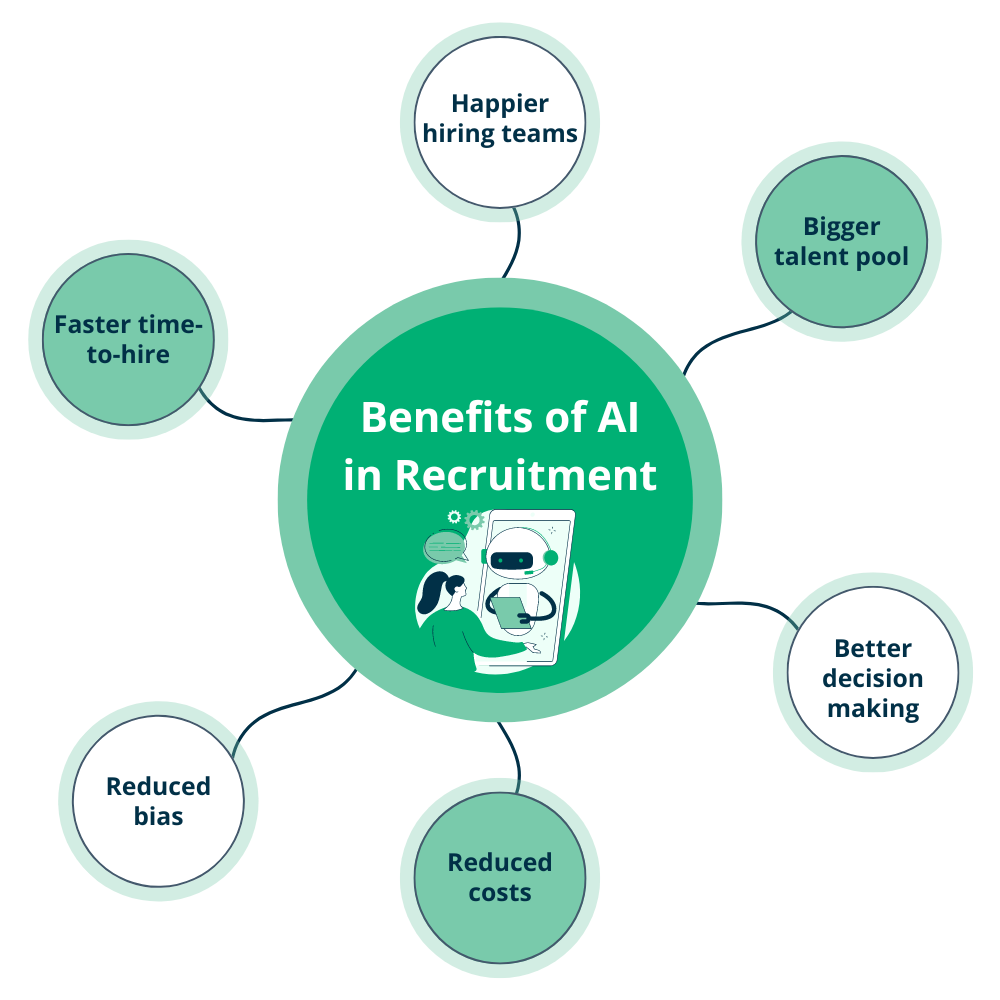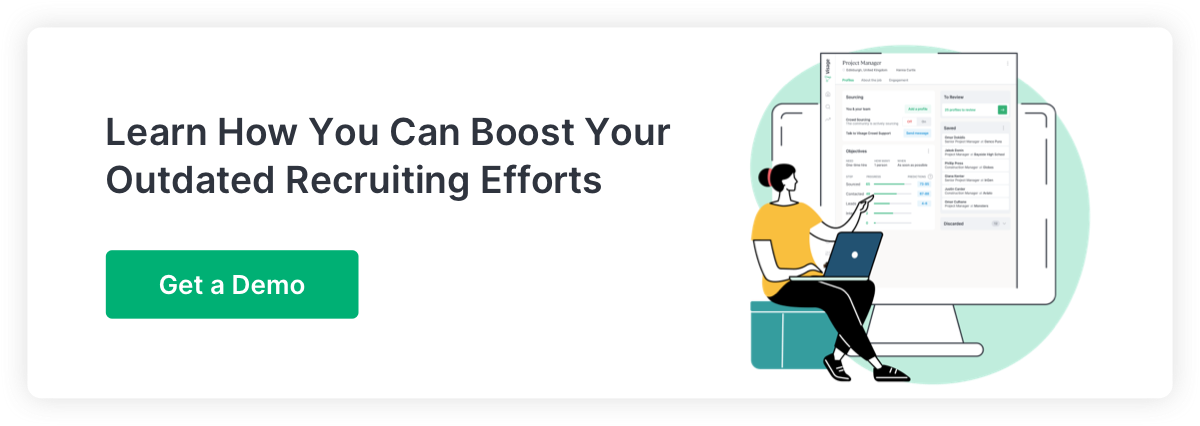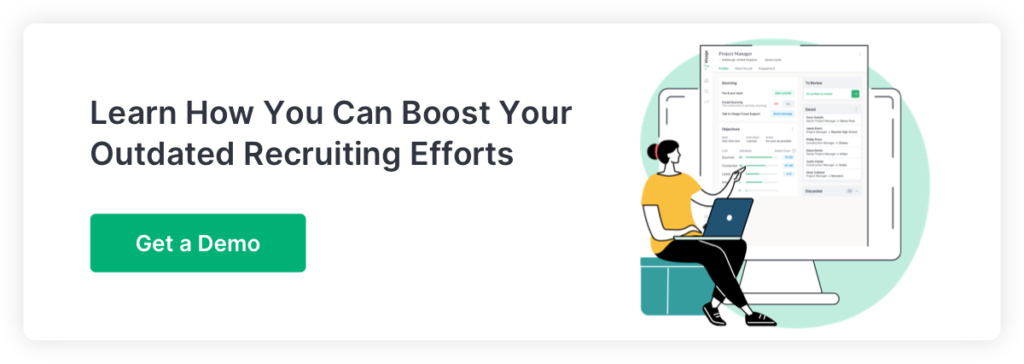Artificial intelligence (AI) has quickly become a favorite tool in the talent acquisition professional’s toolbox, and for good reason. It’s a business innovation that has the power to streamline the entire talent acquisition cycle, and not just in ways that you’d expect.
AI isn’t problem-free, but when headcounts and budgets are shrinking – and targets are not – a little technological innovation can seem like a lifeline. Want to search less and hire better? It’s time to embrace using AI for recruitment.
AI Tackles Traditional Recruitment Roadblocks
When recruiters get together, there’s often an understandable groupwide airing of frustrations. Does any of this sound familiar?
- Sourcing takes too much time.
- Forecasting resources and budgets are never accurate.
- The ideal candidates are hiding.
- The few candidates discovered aren’t suitable.
- Passive talent pipeline? What passive talent pipeline?
- Admin and busywork take all day, every day.
AI can help solve these problems – and more. That’s because you can customize a variety of automation, pattern-recognition, and machine-learning capabilities to streamline and speed up each phase of recruitment.

Automation can reduce workloads by 20% and reduce cost-per-hire by 30%. 63% of recruiting professionals report an improvement in hiring practices since using AI. With data-driven insights and the latest market information, AI empowers recruiters to take on a more consultative role rather than administrative.
Sounds awesome! “But how does it work in the real world?” you ask? Here are some practical ways you can use AI for recruitment.
AI for Talent Sourcing
With AI, you can put the bulk of your sourcing efforts on autopilot. It handles volumes of data quickly and eliminates a ton of manual tasks, which gives recruiters more time for core functions that are best performed by real, live humans.
Using AI for talent sourcing makes sourcing faster and returns quality candidates optimal for your sourcing objectives. Use AI for:
Resource planning: When you’re planning a passive pipelining campaign, it’s important to know how much resource you’ll require. Use AI to predict the effort needed at each stage of the funnel to meet your hiring objectives.
Visage’s AI machine learning, for instance, combines industry data with your ATS data to forecast and update predictions.
Growing the talent pool: Use AI to search through online platforms, job boards, databases and social media to discover potential candidates that would have been overlooked or taken a much longer time to find, if performed by humans.
Sourcing for diversity: AI can reduce bias and promote inclusivity by focusing solely on job or experience-related criteria, and removing information that may spark unconscious affinity or confirmation bias.
Visage, for instance, gives you the option to remove profile images, names, schools, and other bias-generating data to focus solely on skills and experience.
Faster talent sifting: Power your ATS with algorithms to match ideal candidates with your job or funnel requirements. It uses natural language processing algorithms to objectively analyze and extract information from resumes, cover letters and profiles to rank potential candidates on their suitability for the role.
It frees up your hiring team’s time for more intensive and nuanced tasks, such as reviewing candidates or one-to-one engagement activities.
Reducing errors: Use AI to block profiles from countries, companies, or domains that are on your ‘do not contact’ list.
Your recruiters won’t waste their time with no-go candidates. AI’s ability to run a first sweep assessment on collated profiles – to prevent duplication or to highlight possible errors – saves recruiters time, too.
Keeping you legal: AI facilitates global sourcing, but different data privacy requirements can be a nightmare to deploy manually. Use AI to apply local legislation to local candidates automatically.
For example, we’ve programmed the Visage platform to respect GDPR by automatically deleting non-responding GDPR-covered candidate data a set time after the first outreach.
AI for Engagement
The key to successful engagement is personalization and an excellent candidate experience. Although it seems counterintuitive, AI’s capabilities can support personalization and facilitate a customized outreach campaign to build a robust passive talent pipeline.
Customizing engagement emails: Use AI to create a series of personalized engagement emails. You’ll need to take extra care with your messaging when you customize those messages, but AI will handle everything else.
The Visage team has created a range of flexible engagement email templates ready to infuse with your own personality.
Getting more ideas: Ugh! Coming up with new email subject lines that won’t make the candidate hit “delete” is a hideous task. Luckily, AI’s generative and machine-learning capabilities can help create subject lines that are less stiff and, based on historical data, might have a better chance of being opened.
No-hands email cadence: AI automates your outreach email schedule and tracks what you’ve sent as well as any responses. This way, you can avoid hassling the candidate with too many emails and address responses quickly.
AI for Recruitment
Traditionally, recruitment was a heavily loaded process with high-volume, manual tasks.
Writing job descriptions, publishing job ads, matching candidates, answering queries, long- and shortlisting, scheduling interviews, final hire, and onboarding handover – it’s all good, clean, fun but, boy, what a time suck! AI-enabled recruitment frees up recruiter time for higher value tasks like building relationships and data-driven consultancy.
AI can also help by:
Writing job descriptions, ads, and interview questions: Use AI’s generative capacity to create the words you need at each stage of the hiring process. Again, humans will need to review and edit to fine-tune personalization, but you’ll get fresh ideas and AI will get much of the legwork done for you.
Job posting and distribution: AI automates job posting on multiple platforms, including across social media, where many of your passive candidates are lurking. Specially designed algorithms can help place an ad in front of a pool of target candidates.
Answering candidate queries: An AI-driven chatbot that a.) does its job and b.) isn’t super-annoying is a rare feat, but not impossible for handling common questions.
AI For Recruiting: Some Caveats
An AI-driven platform has the potential to pay for itself on Day One. But it can only do this if it’s designed and implemented with care, thought, and skill.
For instance, assumptions and stereotyping at the design stage can infuse a candidate-matching algorithm with unconscious bias. Transparency may be an issue, along with data ownership and governance.
At Visage, we’ve already thought of all this and built a platform backed by a global team of sourcers trained and designed to help you search less, hire more, and hire well. Reach out for a demo. We’d love to show you around.
CEO of Visage & Hopward, Joss is a 15-year veteran in the recruitment industry and a passionate thought leader in optimizing talent acquisition for companies big and small. Hailing from France, but at home on his ranch in Austin, TX, he enjoys free time with his wife and son and plays polo.

